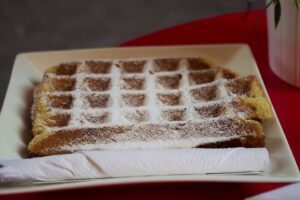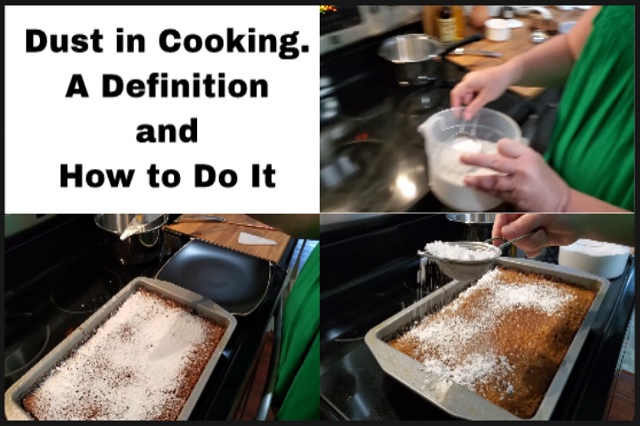Looking to add a little something special to your dishes?
Dusting can give them an extra zing! Get the details on what dust is and how to use it in cooking here.
What Is Dust in Cooking? A Definition and How to Do It
 Dusting is a culinary technique used to coat or lightly cover food, usually with a dry ingredient such as sugar, flour, or spices.
Dusting is a culinary technique used to coat or lightly cover food, usually with a dry ingredient such as sugar, flour, or spices.
It’s a simple way of adding flavour and texture to dishes and can be used to enhance the presentation of certain foods.
Definition and Uses of Dusting.
Dusting is a cooking technique used to coat or lightly cover food with a dry ingredient, such as sugar, flour, or spices.
It’s an easy way to add flavour and texture to dishes and enhance their presentation.
This technique is especially useful for baked goods like muffins, cookies, and cakes.
Dusting with cocoa powder gives desserts a dark chocolate hue; using spices creates color and adds an interesting layer of aromas; and flour can be used as a protective barrier when frying delicate items like zucchini blossoms.
Cake Pan Dusting
Dust can also refer to the process of dusting a baking pan with flour in preparation for cooking.
See Greasing and Flouring a Pan.
Incorporating the Technique into Your Cooking.
Adding the dusting technique to your cooking repertoire is a great way to make homemade food appear more polished and appetizing.
Begin by adding a light coating of flour, sugar, or spices to the food you’re preparing.
Be sure not to overdo it by evenly spreading the ingredient so that it covers the entire surface of the food.
This technique can also be used to give crunchy texture to cookies and cakes before baking them, helping them attain an attractive shape as they bake.
Try different combinations of ingredients and measurements until you find the best flavour for your dishes.
Different Types of Spices and Herbs for Dusting.
When it comes to dusting, the possibilities for flavours are endless.
Experiment with a variety of herbs, spices and nuts like cinnamon, allspice, nutmeg, cardamom, ginger and even cocoa powder or matcha.
You can also combine different flavorings to create unique finishes on your dishes.
The key is to remember that dusting is just one layer of flavor – it should be subtle and should not overpower the dish you’re preparing.
Tips to Perfectly Executing the Technique.
Dusting is a technique that’s very easy to execute but can take a bit of practice to perfect.
For the best results, make sure your seasoning is finely ground and micro-powdery before using it! This will ensure the flavor is amplified in the dish.
Secondly, use an appropriate tool for dusting—ideally shakers or micro-planners.
Finally, be sure to not put too much spice as it can overpower the dish instead of enhancing its taste.
Unique Ways to Use Dusting in Your Cooking.
Dusting is a great way to add flavour and texture to your dishes.
By lightly ‘dusting’ spices and herbs onto different ingredients, you can transform simple dishes into something special in just a few seconds.
Popular ways of dusting include adding powdered sugar to cakes and desserts, sprinkling Paprika onto grilled meats and vegetables or adding Parmesan cheese over pasta dishes.
Get creative with your dusting technique – the possibilities are endless!
The Ultimate Guide on How to Properly Dust a Cake
Get ready to find out the key steps on how you can properly dust your cakes like a professional baker without fail.
Dusting a cake with icing sugar, powdered sugar, or cocoa powder can add an extra touch of elegance to any dessert.
Whether you’re just starting out in the kitchen or have been baking for years, follow this simple guide to ensure your cakes look as delicious as they taste.
Prepare your work surface and the cake.
Before you get started, it’s important to make sure your work surface is clean and the cake you’re working on has cooled completely.
Any crumbs or smudges will be visible on the sugar, so use a pastry brush to gently dust away any debris before proceeding.
Gently place the cake onto your work surface and make sure it is centered and level.
Choose the right type of dusting powder.
When it comes to dusting a cake, the right type of powder will make all the difference.
Consider choosing one with a mild taste such as cocoa, icing sugar or confectioner’s sugar.
Alternatively, opt for luster dust, spray colours or food gels for brighter and more vibrant colours.
For safety reasons, ensure the food powder is non-toxic and FDA approved before using it on your cake.
Dust your cake smoothly with a duster brush, sifter or sieve.
A duster brush, flour sifter or sieve helps you to sprinkle the powder evenly and with precision.
Using a brush
- Dip your brush into the powder, then lightly dust the surface of your cake.
- Make sure you take it slow and move in horizontal or vertical strokes until the entire cake is covered.
- Place the cake gently on top of a cooling rack.
- Pour some powder into a dry mixing bowl then stir and smash it to remove any lumps.
- Carefully pour the powder into your sifter or sieve. Hold it over another emplty bowl to catch the excess.
- Hold the sifter or sieve over the cake and then gently shake out or sift the powder onto the cake until it’s evenly covered with a fine layer of sugar.
This will help you create an almost flawless look on your cake’s surface without leaving any visible brushstrokes.
Using a sieve or sifter
Clean up any excess dusting powder with a cloth.
After you are done dusting your cake, make sure to take a damp cloth and clean up any edges or excess powder.
It is important to get rid of any powder that was not meant to be there as it can ruin your fresh finish.
This will also ensure that the cake looks smooth and professional.
Apply additional decorations such as edible glitter and sprinkles as desired.
Once your cake has been dusted, you can add additional decorations such as edible glitter or sprinkles.
These should be done after the dusting process is complete to avoid any disruption of the cake’s surface.
You want to take special care when handling any powdered decoration so that it does not interfere with the smooth finish you created by dusting.
